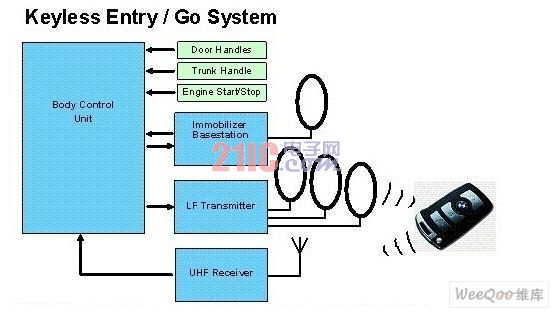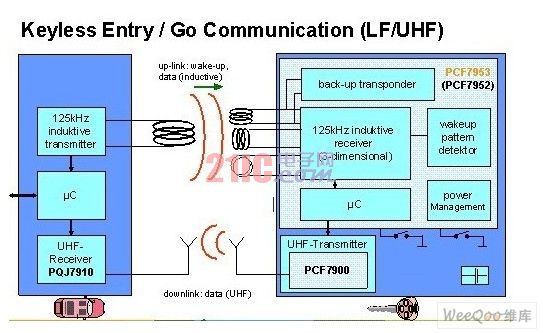In our daily life, cars have not only played the role of a means of transportation, but people have given it more life. The safety and theft of cars have also become very important. This article refers to the address: http:// The remote key (RKE) brings a good user experience and meets people's requirements for convenience and comfort. However, due to the technical limitations of radio frequency one-way communication, it has its own shortcomings in terms of security. The integrated solution (Combi) introduced by NXP Semiconductors (hereinafter referred to as NXP) combines the engine anti-theft and the remote control key into one, which is realized by one chip, which not only improves the safety of the system, but also reduces the cost of the entire key. Gradually replacing the independent remote control key has become the mainstream solution in the European and American markets. Of course, in the radio frequency communication, it still retains one-way communication, and the security is not substantially improved. Let's take a look at how this technology is implemented. As shown in Figure 2, the keyless system requires a total of three areas to be detected: gray out-of-vehicle area, light pink interior area, and gray-white main driving position. The shaded area of ​​gray includes three parts, which respectively represent the effective area of ​​the main door, the auxiliary drive, and the door control of the trunk. When the owner enters this position with the key, the car and the key can establish effective communication through the low frequency signal. The field strength detection, the car can determine the corresponding position of the key, and thus decide to open the corresponding door. The light pink interior is a difficult point in the design of the entire PKE system. It is necessary to accurately determine whether the key is in the car to determine the state of the door and whether the engine can be started. In some high-end models, the gray-white main driving area will be detected, whether the key is valid, whether the main driving position is there, avoiding engine start-up caused by child misoperation, and may also include detection of the area inside the trunk to prevent the key. Was locked into the trunk. In summary, we can find that in the keyless system, the area detection is a very important technology that is different from the previous various automotive security products. Therefore, the accuracy of the area detection becomes an important parameter to measure the quality of a keyless system. At present, there are mainly two corresponding technologies on the market. One is to adjust the sensitivity of the low-frequency signal and then make fuzzy judgment according to whether the communication is stable. The accuracy is limited but convenient to implement. The second is based on the strength detection of the received low-frequency signal. RSSI (Received Signal Strength Indication), according to the size of the low-frequency signal to calculate the relative distance between the key and the low-frequency antenna in the car, through a plurality of low-frequency antenna cross-coverage coverage, accurately locate the specific location of the key. NXP products all use the second technology. To achieve the desired performance parameters, NXP provides a signal sensitivity of a minimum of 2.5 mV for a three-dimensional low-frequency receiver front end, while typical sensitivity values ​​can reach 1 mV. Unlike other solutions, the Successive Approximation ADC, NXP uses a 12-bit Sigma-Delta (Σ-Δ) ADC to eliminate noise interference through multi-point sampling averaging. The best in-car has been implemented. The external detection accuracy is up to 2cm. At present, the accuracy of the in-vehicle inspection required by the depot is usually 5 to 10 cm. The low-frequency transmitting module and the radio-frequency receiving module are the basic communication links of the keyless system. The low-frequency transmission adopts 125KHz, which is the uplink, and is sent from the car to the key end. The radio frequency receiving adopts 315MHz or 434MHz, which is the downlink and the key end. Send to the car. The reason why 125KHz is adopted is that it is compatible with the related technology of engine theft prevention. More importantly, the 125KHz signal is sensitive to the distance, which can realize accurate distance detection and play a key positioning role. The radio frequency uses the traditional RKE frequency band. On the one hand, it is compatible with the basic functions of the remote control key, and it also takes advantage of its fast communication speed. Here, it is important to state that the so-called communication speed refers to the data used for authentication and encryption between the key and the car. Transmission, in order to ensure the process of keyless door opening or ignition in a short time, a higher baud rate (usually 8 to 20 kbps) is required. It is generally not recommended to use a low-end SAW transmission module (about 1 kbps). The implementation is based on a phase-locked loop-based transmitter chip, such as the NXP PCF7900, which has a maximum baud rate of up to 20 kbps in FSK mode. Also for this purpose, the RF band also has a trend of using higher frequency 868MHz or 915MHz. As shown in the figure, the low-frequency transmitting module includes a plurality of low-frequency antennas, which are installed in the door handle for keyless entry and are installed inside the vehicle body for keyless start (keyless start). The specific block diagram of the key end is shown in Figure 4. The main chip is the PCF7952 or PCF7953 of NXP, the RFF chip adopts the PCF7900 of NXP, and the corresponding RF receiving chip on the car side is the PQJ7910 of NXP. The PCF7952/53 has a low frequency analog front end (LF Front End) for connecting peripheral 3D antennas. In the keyless system, the key end needs an external 3D low frequency antenna, which can receive the 3D energy field strength of the external space, which are X, Y, and Z axes respectively. By superimposing the energy in three directions, the key can be guaranteed at any angle. The same field strength can be detected. One of the axis antennas is also multiplexed into the IMMO function to enable engine start in the no power mode. Through the uplink and downlink, the key and the car can establish two-way communication for complex identity authentication. The latest generation of authentication technology is called Mutual-Authentication. It requires not only the car to authenticate the key, but also the key to determine whether the car is legal. Any error will lead to the end of the entire communication, thus ensuring the security of the system. . The communication distance is determined by the low frequency uplink 125KHz. The effective working distance of the normal PKE system is about 2.5m, and the actual effective switching distance is 1.5m~2m. In addition to the detection accuracy inside and outside the car, the power consumption of the key end is also an important indicator to measure the quality of a keyless system. The power management module of the PCF7952 can reduce the power consumption of the whole system to the greatest extent. A mature keyless system solution and key With a 2032 3V lithium battery powered, the battery life can be as long as three years. After the keyless system, where will the car safety and anti-theft products go? NXP has given the exact answer: Keylink, the next generation of car keys. Its biggest breakthrough is to connect the car key with the peripheral intelligent terminal, so that the key can be connected to a wireless connection such as a mobile phone, a PDA, etc., by means of the display function and powerful processing capability of the smart terminal such as a mobile phone, Unparalleled application space is in front of us: Always check the vehicle status, door and window status, fuel tank volume, interior temperature... display on the phone screen. Looking for a car, through the cooperation of the key and the mobile phone, the GPS navigation of the mobile phone can help you find the parking place easily. Easily make travel routes and deposit selected travel routes in front of your computer. When entering the car, the car navigation device will automatically import the travel information. Vehicle maintenance, vehicle documentation, and maintenance records are all in the key for easy maintenance. There are many more applications like the above. The following news is another new application of Keylink, which allows us to understand this technology more closely, and also as the end of this article: October 22, 2008 - BMW Technology R&D and NXP Semiconductors (an independent semiconductor company founded by Philips) launched the world's first prototype of a multi-function car key. This prototype features contactless payment, personal access control and advanced public transport electronic ticketing for a more mobile experience. Equipped with NXP's SmartMX security chip, this prototype is the first to enable drivers to make fast, secure and convenient electronic payments via car keys, creating an exciting new application environment for future consumers.
High resolution and high density LED Display for advertising;Its high uniformity and seamless splicing ensure picture quality;High brightness and widely viewing angle allow people from different viewing distance to see it;Low power consumption made it energy saving and environment friendly;Designed with fast heating spread system to protect screen effectively and increase its life span;The Advertising LED Standing IPoster can present all kinds of contents,including graph, pictures, flashes, videos and any other formats with your PC does synchronously.
Bako Vision LED IPoster features:Extreme light and extreme thin, install solution once plug, using without any setting front maintain, fast and simple unit install, wireless connection intelligent management, easy master.Customizable size and mounting options available. Size are determined by configurations of modules. Update your digital content in our built-in media player via WiFi or USB.
Applications: The LED Player Monitor for Advertising can be used for advertisement in stage, stadium, exhibition, TV-Show, mansion video wall, shopping mall, banks, schools, bus station, airport, gym, market, factories, monitoring centers, hospitals, bars etc.
Led Iposter,Hd Iposter,Led Stand Poster,Indoor Led Iposter Shenzhen Bako Vision Technology Co., Ltd. , http://www.rentalleddisplays.com
In 2003, NXP introduced a keyless system (PKE or PEPS), which completely changed the development prospects of automotive security applications, bringing users a new experience of comfort and convenience: the owner does not need to use the key during the entire driving process. Just carry it with you. When the owner enters the effective range near the car, the car will automatically detect the key and identify it. If the driver succeeds, the door or trunk will be opened accordingly. When the owner enters the car, he only needs to press the engine start button, and the car will automatically detect the key. Position, determine whether the key is in the car, whether it is in the main driving position, if successful, start the engine. Don't underestimate this seemingly inconspicuous change, it plays a major role in simplifying your life. The keyless system not only brings comfort and convenience, but also has an essential improvement in safety. Through two-way communication between low frequency and radio frequency, complex two-way identity authentication can be completed between the car and the key, in terms of security. Similar to engine burglar, it is much better than traditional remote control keys. Since the successful mass production of keyless systems for a small number of high-end models in 2003, the global market has spent two to three years promoting the technology. At present, almost every major car manufacturer in the world has NXP keyless products covering the high-end The models are even low-end models. 
The block diagram of the keyless system is shown in Figure 3. The left side is the car end, including the main controller (Body Control Unit), the door handle and the trunk handle trigger module, the engine one-button start module, and the engine anti-theft base station module (IMMO Basestation). ), low frequency transmitter module and RF receiver module. Three of the green modules are mainly used to trigger the entire system. When the owner pulls the door or presses a button to activate the button, the corresponding module will send an interrupt signal to wake up the master MCU and start the entire communication process. Common keyless system operating modes are divided into two categories: trigger mode and polling mode. The trigger mode is divided into mechanical trigger and electronic induction trigger. Here, the system cost and system performance, such as the response time of the whole system, need to be considered comprehensively. The engine anti-theft base station module is a low-frequency communication module (125KHz), which is used to realize close-range communication with the key and start the engine. This function is an alternative solution, also called “no power modeâ€, only when the key battery is exhausted or there is accidental interference. The keyless system will not work when it is not working properly. In this case, the user only needs to hold the key in a fixed position (such as a groove), and the key can establish communication with the base station to perform identity authentication to start the engine. A key feature of NXP's keyless system PCF7952 and PCF7953 is that the chip itself integrates engine anti-theft function and is fully compatible with all NXP Transponder products, including PCF7936. This greatly improves the reliability of the system and does not require additional cost, as will be mentioned later. 
Figure 3: Block diagram of a keyless system 
Figure 4: Block diagram of the key terminal 